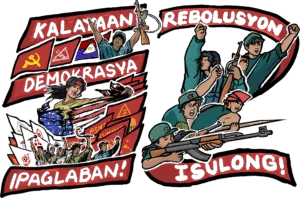The four decades of revolutionary fighting in the region
The CPP and the revolutionary movement in the region persevered, grew robust and became honed, and contributed to the general endeavor to advance the Philippine revolution in the past four decades. This despite the unrelenting counterrevolutionary suppression campaigns of the reactionary state. By such is affirmed the just cause and correct line of the Party, as well as the indomitable spirit of the masses to wage revolution and liberate themselves from exploitation and oppression.
The CPP and the armed revolutionary movement were sown and took hold in Eastern Visayas in the early years of the 1970s. This came about from the impetus of the democratic mass movement in the urban areas in the islands at that time, and also spurred by the First Great Rectification Movement of the newly reestablished CPP. From these came the first batch of activists and members of the Party in the region. Many of them went to the countryside of Samar and Leyte in heeding the call of the CPP to establish the revolutionary armed struggle throughout the Philippines.
They established the armed revolution in various parts of the region. From nothing, the initial revolutionary bases among the ranks of the peasants sprang up, and the first units of the NPA formed and armed themselves by launching guerrilla warfare. Great sacrifices were made in these initial efforts. The revolutionary forces and the Party in general were neophytes still accumulating experience. The brutal campaign of the Marcos dictatorship aimed to nip the revolutionary movement in the bud.
With higher organ guidance, the regional Party leadership summed up five years of revolutionary practice in 1976. The orientations and policies on many issues were clarified, the study courses were made and the comprehensive regional social-investigation completed. The study of revolutionary theory, summing up of practice and investigation of concrete conditions were enthusiastically undertaken by the entire revolutionary movement in the region. Because of these, the revolutionary forces became all the more inspired and dedicated in pressing forward with their tasks.
From 1977-1985, the revolutionary fight progressed in an all-around way. The antifeudal struggles gained momentum from formerly in the barrios toward inter-barrio, municipal and inter-municipal levels. The NPA widely and intensively launched ambushes and raids against the weak points of the reactionary army in three to four tactical offensives every month on average. Seizing weapons from isolated enemy elements became widespread among the masses. The rate of growth of the recruits and units of the NPA accelerated based also on the increasing number of arms confiscated from the enemy. The guerrilla zones and bases widened and strengthened until our formerly far-flung areas interconnected.
During this time the revolutionary mass movement was also established in the cities and towns of all the provinces. Based on the advancing revolutionary mass struggle and guerrilla warfare, the Party and the revolutionary united front reached out on a broad scale for the revolution and against reaction. The region's accumulated revolutionary victories also notably supported the national effort to extend guerrilla warfare throughout the archipelago by contributing cadres and weapons, aside from imparting revolutionary experience.
Yet along with garnering significant victories, there was also the mounting up of the Party’s weaknesses and shortcomings in the region. There was the weakening of the study of revolutionary theory and investigation of concrete conditions, and the piling up of various splendid experiences that were not summed up. With that came the diminishing of the Party's capacity to lead the increasingly complicated revolutionary fight. The antifeudal mass movement ebbed and many problems in establishing mass bases arose. The trend towards impetuosity became pronounced in the forms of military adventurism and the purely-military outlook. The region was easily permeated by the wrong line that spread at this time inside the Party and the revolutionary movement.
In 1986 the wrong line became dominant in the region with the implementation here of the national policy of the strategic counteroffensive. This policy sought quick victory via raising the level of warfare in the countryside along with instigating urban uprisings, which were beyond the actual level of the revolutionary movement as well as lacking the step by step political requisites. This spurred on the earlier weaknesses of the Party in the region.
The wrong line caused great imbalance and disorientation in revolutionary work. The major effects were: Overemphasis on military work and the severe sacrifice of political work that strengthened the purely-military viewpoint in various aspects of work. Obsession with creating an insurrectionary situation in the cities through repetitively straining mass mobilizations that diminished the solid strength of the mass movement in the barrios and the cities; tied down increasing numbers of cadres in urban basing that led to the rotting away of not just a few of them, and resulted in dwindling support from the cities for the armed struggle and mass movement in the countryside. Being carried away by winning over the middle forces and some reactionaries, just to add up more numbers for the grand schemes for urban uprising, in a way that compromised the basic interests of the basic masses and the revolution and encouraged reformism.
After some years of short-lived gains in the SCO campaign, the serious vulnerabilities that arose from the wrong line quickly set in. The Aquino regime and the AFP swiftly took advantage of these beginning in 1988 by launching a savage offensive through Oplan Lambat Bitag against the armed strength and mass base of the revolution. The revolutionary movement suffered losses and decline unparalleled in history.
The Party in the region endeavored to save the situation. The unsustainable big NPA formations were reduced and mobilized in mass work to recover and repair the mass base. In this effort there was the striving to consolidate the Party and the revolutionary forces. But because of the continuing trend of military adventurism and its accompanying errors until 1992, the rapid decline in various fields of work was not stopped.
With wholehearted joy, the Party in the region responded to the call of the Central Committee to launch the Second Great Rectification Movement. We were enlightened that the roots of our frustrations, decline and losses till that time was the upper hand gained by the wrong line of impetuosity beyond the realizable, which was borne out of the neglect to consolidate in the ideology, politics and organization of the Party. We were enlightened that the key to reverse the downward trend towards advancing once more was to fully identify, criticize and reject the errors and revivify the Party.
From 1993-1999 the entire Party organization in the region unreservedly plunged into the various efforts of all-around rectification. The Party cleaned up the disorientations in theory and learned the basic revolutionary principles, line and policy; thoroughly summed up past practice and identified, criticized and rejected the major errors and weaknesses; and undertook the profound gauging of the regional situation. Democratic centralism was tightened and the baggage of bureaucratism, ultrademocracy, liberalism and opportunism discarded; the capability of the cadres and leadership was raised; and the Party life of the membership came back as revitalized and close-knit.
The process of rectification wasn't smooth sailing. The Party carried out the major internal overhaul while striving to also arrest the downward trend, which persisted till 1995, in the face of a fierce “last two minutes” enemy offensive that aimed to deliver the death blow to the revolutionary movement in the region. But the Party and the revolutionary movement defeated the enemy initiative. The downward trend was finally stopped in 1996 and the reversal to steady advance began and gained momentum year by year.
The Party and the revolutionary movement in the region greeted the first decade of the new millennium with greater strength and confidence compared to anytime in the past, great thanks to the SGRM. We have already recovered and strengthened a wider area and mass base. The antifeudal peasant mass struggles in various parts of Leyte and Samar flared up once more especially in the early years of the decade 2000. Every year since 1999 till today, the tactical offensives and weapons seized from the enemy by the NPA continue to increase. The NPA continues to grow and has surpassed its former peak in the 1980s. More importantly, the NPA is now far more consolidated and honed in comprehensive work compared to anytime in the past.
Aside from recovering, the revolutionary movement in the urban areas of the region also achieved significant victories in breaking through many fields of work and in many areas. The new vitality and vigor of the revolutionary movement in the region bore fruitful victories in united front work such as the contribution to the national mass struggle to depose the Estrada regime in 2000, driving out the butcher Gen. Palparan from the region in 2005, and the triumphs in the increasingly adept application of revolutionary dual tactics in responding to reactionary elections.

